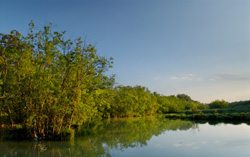Using river deposits to sequester carbon dioxide
River-dominated ocean margins (RIOMARs) are responsible for approximately half of the carbon exchanged between land and ocean. However, despite their role as sites of long-term burial of organic matter (OM), the factors that control carbon sequestration in river subaqueous deltas are poorly understood. In particular, information regarding the contribution of perturbation phenomena such as floods is lacking. To address this issue, the EU-funded Somflood project proposed to analyse the composition of OM in sediments from the Po River in Italy. The main objective was to study the effects of key physical phenomena on the processes responsible for the cycling and ultimate fate of OM in the flood deposit. Project members performed a series of analyses testing the composition and physical properties of material along distributary channels. Material was collected along the distributary channels and – contrary to what had initially been hypothesised – it was found that the OM retained its composition independently of the prodelta morphology and river discharge. However, further work is required to address the role of large floods in the transfer of material from land to the coastal system. The Somflood study provided invaluable information on the influence of the internal architecture of prodeltaic systems on land-ocean exchange of carbon. This knowledge will help scientists exploit river sediments to capture and store CO2 from the atmosphere.

